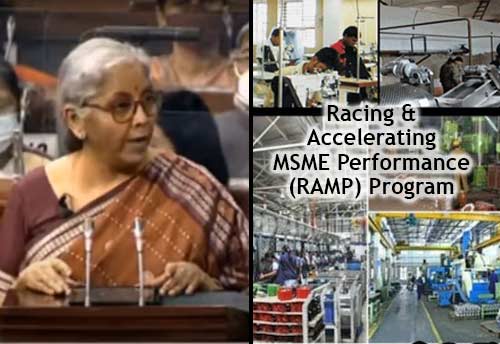‘RAMP’ing up the MSMEs
The Finance Minister, Smt. Nirmala Sitaraman, made a slew of MSME-oriented announcements in the Budget 2022-23, on 1 Feb 2022. Of all the key statements, the one that captured the nation’s attention was the rollout of the RAMP program over the next five years. The government has announced a few initiatives to revitalize the Micro, Small, and Medium Enterprises in India to battle the post-Covid survival struggle, and RAMP is one of them. However, it is noteworthy that this program is one of the MSME-focused long-term initiatives by size and scope in recent years.
What does RAMP mean?
Raising and Accelerating MSME Performance program or RAMP is a five-year government scheme proposed to boost productivity and credit for the Covid-hit MSME sector. The government plans to partner with the World Bank for five years between FY22 to FY26 for this project.
The centre has allocated a total project cost of Rs. 6,062.45 crore last year. The World Bank’s contribution to the total cost was reserved at Rs. 3,750 crore under the Credit Linked Capital Subsidy and Technology Upgradation Scheme. RAMP is only the second program for MSMEs approved by the World Bank, the first being Emergency Response Program for Micro, Small, and Medium Enterprises. The ERP scheme approved Rs 5,600 crore in June 2020.
Why was RAMP introduced?
In a bid to improve the agility of MSMEs, the government has introduced RAMP in the FY22 budget. It was launched based on suggestions from the UK Sinha Committee report in June 2019. The Committee had put forth multiple financial, economic, and regulatory reform recommendations for the upliftment of MSMEs and to overcome crucial challenges such as lack of access to affordable credit and capacity building.
RAMP was introduced to handle the liquidity issues of over 1.5 million MSMEs. Credit was transacted through targeted guarantees to encourage non-banking financial companies (NBFCs) and other financial institutions to lend to viable MSMEs. Data from the World Bank suggests that as of June 2021, nearly 50 lakh enterprises benefited from the first program.
How does RAMP initiative help MSME?
The initiative will focus on two key aspects:
- Bolstering institutional capacity and coordination for MSMEs.
- Supporting MSME’s abilities and entry to markets and credit.
According to the World Bank, only 40% of about 58 million MSMEs in India have access to financial sources. The RAMP program will act as an intermediary platform in which suppliers and MSMEs come together and ensure that the sector is scaling up by providing access to official sources of finance. This initiative was initiated to provide support to MSMEs hit by the COVID -19 pandemic and its consequences.
World Bank announced that MSME guidelines and programs are being implemented in ministries and departments across the country. This includes key players such as the Reserve Bank of India (RBI) and the Small Industries and Development Bank of India (SIDBI). It indicates the immediate need for convergence of policies, programs, and schemes across all levels.
State-level strategic plans will provide better access to finance and capital for small and medium enterprises. It also aims to upscale online dispute resolution mechanisms to speed the currently delayed payment processes. These efforts improve the cost-effectiveness, quality, accessibility, impact, and outreach of such schemes.
In a statement given by Junaid Ahmad, World Bank Country Director, in India last year, he states that “The RAMP programme will intensify efforts to support firms to return to pre-Covid crisis production and employment levels, while laying the foundations for longer-term productivity-driven growth and generation of much-needed jobs in the MSME sector.”
The RAMP rollout
Initially, the program will focus on the first five states, namely, Gujarat, Tamil Nadu, Maharashtra, Punjab, and Rajasthan, which account for nearly 54% of total MSMEs in the country. Detailed guidelines and policies addressing the eligibility criteria, repayment, application, disbursement process, etc. are yet to be released by the central authorities.
Conclusion
Enhanced fund allocation and digital adoption, will have a direct impact on financial inclusion, within the MSME sector. This, in turn, will boost the agility and resilience of the businesses that identify themselves as Micro, Small, and Medium Enterprises. This year’s budget has evidently recognized the credit crunch and liquidity crises faced by MSMEs, and the new policies provide leeway for the sector to access credit and finances easily.


